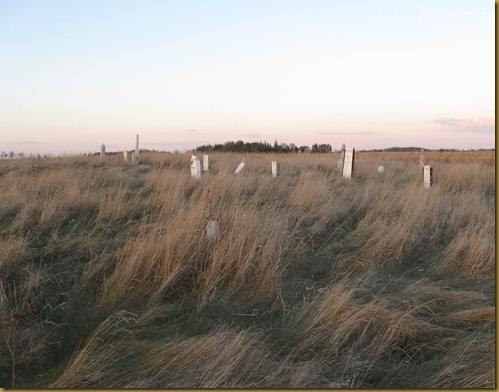

Wednesday, January 4, 2012
Monday, January 2, 2012
Military Monday–Hoping for a Homecoming, Part I
“I am trying not to openly speculate about the circumstances and events surrounding the missing crew of KW 161. Even though your uncle has been declared KIA, he is still missing.” Those words, emailed to me by a correspondent regarding Raymond Christensen, ran through the back of my mind for most of the next few days. In any idle moment I had, this sentence would resurface as I tried to put together everything I’d learned over the past few weeks and make sense of it.
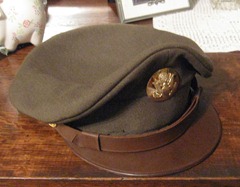 My correspondent, David, who is a collector of military items and a veteran himself, had read my blog post regarding my uncle Raymond, who, along with his pilot Joseph Leonard, were lost when their plane went crashing down into the Tyrrhenian Sea near Montecristo late on the night of May 13, 1944. David had found a soldier’s cap with the name Lt. Joseph E. Leonard on it, and was doing some internet research to learn more about this fallen hero. We exchanged information – I had information on Ray, including a Missing Air Crew Report, and he had expertise on all things military, and so our conversations began.
My correspondent, David, who is a collector of military items and a veteran himself, had read my blog post regarding my uncle Raymond, who, along with his pilot Joseph Leonard, were lost when their plane went crashing down into the Tyrrhenian Sea near Montecristo late on the night of May 13, 1944. David had found a soldier’s cap with the name Lt. Joseph E. Leonard on it, and was doing some internet research to learn more about this fallen hero. We exchanged information – I had information on Ray, including a Missing Air Crew Report, and he had expertise on all things military, and so our conversations began.
Since our family was notified of Raymond’s status back in 1944, little has changed. The last we heard, the crew of the Bristol Beaufighter KW 161 was missing and unaccounted for. All that remained at the site of the wreckage was “much debris, an oil slick, and two life rafts.” End of story.
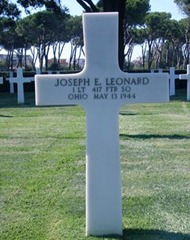
It was during these exchanges when David told me that Lt. Joseph Leonard was buried at the Sicily Rome American Cemetery in Nettuno, Italy: Plot H, Row 9, Grave 40. What? Raymond Christensen was not buried there, nor was he listed among any of the other identified soldiers in overseas cemeteries. Both men went down in the same location at the same time. One was recovered. One was not?
David’s words eventually sunk in: He was telling me there may be a possibility that Raymond’s remains were not lost, but unidentified. Dog tags, David explained to me, were typically the only means of identifying remains, and if Raymond had lost his dog tags in the events of that night, he may have been recovered but not identified.
More to come.
 My correspondent, David, who is a collector of military items and a veteran himself, had read my blog post regarding my uncle Raymond, who, along with his pilot Joseph Leonard, were lost when their plane went crashing down into the Tyrrhenian Sea near Montecristo late on the night of May 13, 1944. David had found a soldier’s cap with the name Lt. Joseph E. Leonard on it, and was doing some internet research to learn more about this fallen hero. We exchanged information – I had information on Ray, including a Missing Air Crew Report, and he had expertise on all things military, and so our conversations began.
My correspondent, David, who is a collector of military items and a veteran himself, had read my blog post regarding my uncle Raymond, who, along with his pilot Joseph Leonard, were lost when their plane went crashing down into the Tyrrhenian Sea near Montecristo late on the night of May 13, 1944. David had found a soldier’s cap with the name Lt. Joseph E. Leonard on it, and was doing some internet research to learn more about this fallen hero. We exchanged information – I had information on Ray, including a Missing Air Crew Report, and he had expertise on all things military, and so our conversations began.Since our family was notified of Raymond’s status back in 1944, little has changed. The last we heard, the crew of the Bristol Beaufighter KW 161 was missing and unaccounted for. All that remained at the site of the wreckage was “much debris, an oil slick, and two life rafts.” End of story.

It was during these exchanges when David told me that Lt. Joseph Leonard was buried at the Sicily Rome American Cemetery in Nettuno, Italy: Plot H, Row 9, Grave 40. What? Raymond Christensen was not buried there, nor was he listed among any of the other identified soldiers in overseas cemeteries. Both men went down in the same location at the same time. One was recovered. One was not?
David’s words eventually sunk in: He was telling me there may be a possibility that Raymond’s remains were not lost, but unidentified. Dog tags, David explained to me, were typically the only means of identifying remains, and if Raymond had lost his dog tags in the events of that night, he may have been recovered but not identified.
More to come.
Saturday, December 31, 2011
2011–The Year in Review
 As I sit here pondering the end of another year, sometimes it’s the hard times that seem to rise to the surface of my consciousness more quickly than anything else. The low point of the year was losing a good friend and genealogy partner, John Melton, quite unexpectedly. I had the blessing of working with John on various projects off and on for the last ten years, and will miss his unending energy and his sense of humor. Rest in peace, friend.
As I sit here pondering the end of another year, sometimes it’s the hard times that seem to rise to the surface of my consciousness more quickly than anything else. The low point of the year was losing a good friend and genealogy partner, John Melton, quite unexpectedly. I had the blessing of working with John on various projects off and on for the last ten years, and will miss his unending energy and his sense of humor. Rest in peace, friend.
I also had to say goodbye to one of those rare places on earth that, when you look at it, fills you with abundant history and happy memories. Voorhees Hall, the main building of long-defunct Huron College, was torn down after 100+ years of service. I loved the beautiful architecture of every part of it, and enjoyed my years there, especially sitting on the north steps smoking a cigarette between classes with all of the other slaves to the habit, and met some wonderful people while doing so. It will be hard to drive past that site and not see it there.
On a more positive note -
I started what hopefully will be the most fruitful thing I’ve ever done, at least in genealogy terms. I’ve blogged about my great-uncle, Flight Officer Raymond Christensen, whose Beaufighter plunged into the sea near Corsica while tangling with the Nazis. I’ll be blogging more about this, but to make a long story short, through one of those Genealogy Angels, I’ve discovered that the body of Ray’s pilot, Joseph Leonard, HAD been recovered and identified. This certainly increases the chances that Ray’s body was recovered as well, perhaps just not identified. Our family has begun the process of looking for a match, aided by mitochonrial DNA. Perhaps 2012 will be the year we can bring Ray home to rest.
I’ve been able to scale of couple of other genealogy mountains in 2011 as well. After years of trying to positively identify the parents of Charlotte DeBolt, it looks likely that her father was Patrick Burnside(s) of Ohio. A book of will abstracts was published years ago listed among Patrick’s heirs a Charlotte DeBolt and her husband William DeBolt. Hmmm… my Charlotte’s husband was Daniel DeBolt. I got the entire probate packet and later in the probate, Charlotte is again mentioned with her correct husband, Daniel. The initial mention of William was perhaps an error, as her brother, another heir, was also named William and listed next after Charlotte. I’d like to find at least one more solid indication of a relationship between Charlotte and Patrick Burnside before I’m ready to call this mystery “solved”, but this is a wonderful piece of evidence.
In addition to continuing with my ProGen Study Group, I also took on another county site for Genealogy Trails – Peoria County, Illinois. This is a special county for me, as my ancestors hail from there, and I used to have a Peoria county website that operated independently, but after nine years, had to take it off-line. I’m glad to be “back in the saddle” and involved with Peoria County’s rich history and pioneer families, and grateful to the site’s former host for all of her hard work in making this a fantastic resource for Illinois researchers. I look forward to adding a ton of data to the site in 2012. In addition to the Peoria County site, I’m still hosting the South Dakota state site, as well as Beadle and Hand County sites.
I’m looking forward to an exciting, even exhilarating, 2012, and wish the same for all of you!
Saturday, December 3, 2011
Scrapbook Saturday–A Working Gal
Another page from the scrapbook of my mother-in-law, who was a fixture at the Hand County (South Dakota) Courthouse for 50 years, working for the Highway Department.
The National Youth Association’s representative recommended Louise for a job after her high school graduation in 1937. Her first assignment was bookwork on easements for Highway 14 through Hand County. Later, she did bookwork for the WPA Road projects in the county for 20 cents an hour. Her bookkeeping methods became perfected over the years, and used as a model for other departments. A copy of a letter from another Highway Department bookkeeper, written in 1963, was used on this page. It reads in part as follows:
“I am the Hwy. Bkpr. for Potter County, and the State Auditing Department has criticized me to a crisp for being to [sic] slow in getting out my yearly report.
“They recommend your books and your system as the peak of perfection, and suggested that I ask you for an appointment and do it as you do it.
“I have worked a great deal and I understand that time is a precious commodity for the gal that works, if you are able to find time to take me on for a bookwork discussion, I will be most glad to reimburse you for your kindness.”
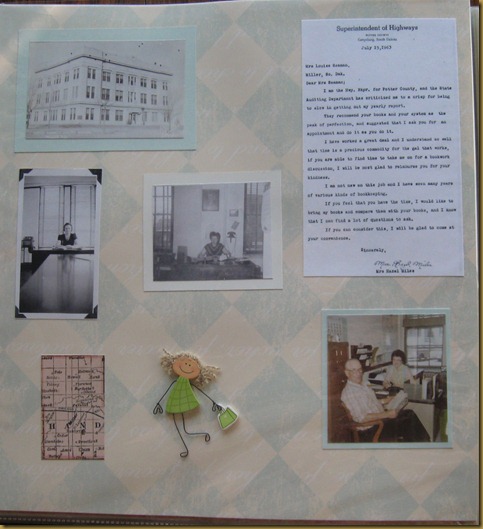
In 1977, South Dakota Governor Dick Kneip proclaimed “Louise Ulmer Day” in recognition of her numerous contributions over the years. Hand County was always a very important part of her life.
The National Youth Association’s representative recommended Louise for a job after her high school graduation in 1937. Her first assignment was bookwork on easements for Highway 14 through Hand County. Later, she did bookwork for the WPA Road projects in the county for 20 cents an hour. Her bookkeeping methods became perfected over the years, and used as a model for other departments. A copy of a letter from another Highway Department bookkeeper, written in 1963, was used on this page. It reads in part as follows:
“I am the Hwy. Bkpr. for Potter County, and the State Auditing Department has criticized me to a crisp for being to [sic] slow in getting out my yearly report.
“They recommend your books and your system as the peak of perfection, and suggested that I ask you for an appointment and do it as you do it.
“I have worked a great deal and I understand that time is a precious commodity for the gal that works, if you are able to find time to take me on for a bookwork discussion, I will be most glad to reimburse you for your kindness.”

In 1977, South Dakota Governor Dick Kneip proclaimed “Louise Ulmer Day” in recognition of her numerous contributions over the years. Hand County was always a very important part of her life.
Saturday, November 26, 2011
Scrapbook Saturday–Photo Pedigree
Another page from my mother-in-law’s scrapbook. I love the photo pedigrees, although this one spans only three generations. I love looking at their faces, noting resemblances, etc.
Louise starts – followed by her parents, Casper J. Kluthe and Jennie Schlechter. Casper’s parents were Casper Kluthe and Maria Katherina “Katie” Kleine, both German immigrants. Jennie’s parents, also German immigrants, were Conrad Schlechter and Johanna “Jennie” Grewe.
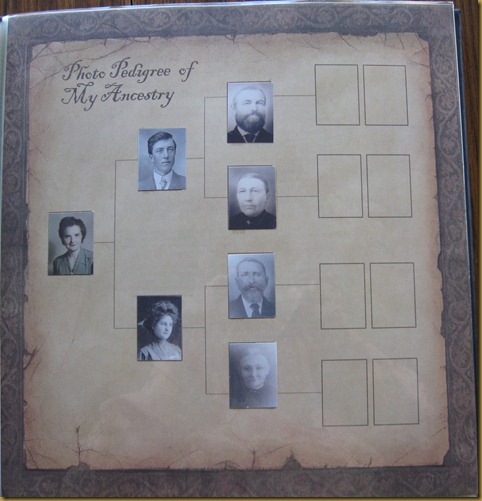
Louise starts – followed by her parents, Casper J. Kluthe and Jennie Schlechter. Casper’s parents were Casper Kluthe and Maria Katherina “Katie” Kleine, both German immigrants. Jennie’s parents, also German immigrants, were Conrad Schlechter and Johanna “Jennie” Grewe.

Saturday, November 19, 2011
Scrapbook Saturday - "House of Used-To-Be"
A page from the scrapbook of my mother-in-law, describing the early farm home of her family, now gone.


Labels:
Genealogy Crafts,
Kluthe,
Seeman,
Ulmer
Location:
Hand, South Dakota, USA
Sunday, October 23, 2011
Genealogy, Family History, and Censorship
As a volunteer for Genealogy Trails, and as a person trying to be a “good neighbor” in the genealogy world, I spend a fair amount of time transcribing public domain materials that might be of help to someone else researching their family history. While traveling, I oftentimes make unexpected stops at small rural cemeteries and snap a few headstone shots for Find-a-grave. I’ve been helped immensely by others doing the same thing, and want to pay back as much as I can. One never knows when some little nugget they’ve put online might be just the thing to put a chip in someone else’s brick wall.
I started a blog, Sharing Genealogy, for making available oddball items I run across, or find sitting on my office bookshelves. Awhile back, I found a book on the history of St. Paul, Minnesota, which I picked up at a library book sale. I personally have no ties to St. Paul, but someone, somewhere does, and thumbing through it, I found some interesting stories, and some old photos. So I decided to start scanning and transcribing it – all 222 pages. All was going well, until September 30, when Chapter XIII was posted – “Chippewas and Sioux.” The next thing you know, I have an ugly, anonymous comment posted questioning my motives and calling this post “bigoted and ethocentric white man crap.”
I answered as politely as I could, but that wasn’t the end of it. Thanks to comment moderation, no more hateful venom is online. But it does bring up the point of censorship – is it right? Should we, as sharers of the past, be held responsible for editing another’s work? If yes, whose standards do we use? Our own? Or the standards of the most sensitive persons that might read our blogs? If the latter, will we offend someone who resents our editing? Is there a “happy medium”, and if so, how do we define it? Only one thing is clear – this is muddy water.
Subscribe to:
Posts (Atom)